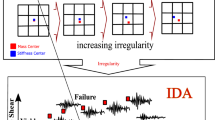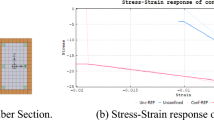Abstract.
In earthquake-prone countries, structures may be exposed to several seismic loads in any stage of building’s life. It is expected that the structures designed by engineers will show ductile behaviour under the effect of vertical and lateral loads and remain stable without making a sudden collapse. In consequence of nonlinear behaviour, plastic hinges are expected to form in structural members which are under the effect of external loads. Earthquake input energy is dissipated in plastic hinges, so, structures behave ductile. In this study, total energy of RC frames is calculated and the energy-based base shear force is determined by equating the total internal energy to the work done by external lateral design forces for pre-selected target displacement and collapse mechanism. Sections of RC frames are controlled if they can resist the calculated design lateral loads or not. If the capacity of the sections cannot withstand the external design loads, the design is rearranged and new sections are chosen. Beam and column sections that can resist the design loads securely are accepted as final sections of the energy-based design methodology. Pre-selected target displacement for desired performance level is checked using the results of nonlinear analyses. The results of the presented design methodology in this study are compatible with the results of nonlinear analyses.

















Similar content being viewed by others
References
Acun B and Sucuoglu H 2007 Structural performance assessment of R/C column members with energy based procedures. Proc. 6th National Conference on Earthquake Engineering; Istanbul Turkey: 85–96 [in Turkish]
Acun B and Sucuoglu H 2010 Performance of R/C columns designed for flexure under severe displacement cycles. ACI Struct. J. 107(3): 364–371
Akbas B 1997 Energy-based earthquake resistant design of steel moment resisting frames. Ph.D. Dissertation. Department of Civil and Architectural Engineering, Illionis Institute of Technology, USA
Akbas B and Shen J 1996 Energy-based earthquake resistant design. Department of Civil and Architectural Engineering, Illinois Institute of Technology; Report No: IIT-CAE-96/005
Akbas B and Shen J 2002 Energy approach in performance-based earthquake resistant design (PB-EQRD). Proc. 12th European Conference on Earthquake Engineering; London, UK, Paper No. 043
Akbas B and Shen J 2003 Earthquake-resistant design and energy concepts. Technical J. Turkish Chamber of Civil Engineers 14(2): 2877–2901
Akbas B, Shen J and Hao H 2001 Energy approach in performance-based seismic design of steel moment resisting frames for basic safety objective. The Struct. Design of Tall Building 10(3): 193–217
Akbas B, Shen J and Cetiner A N 2002 Energy approach in performance-based earthquake resistant design and determining the reliability of SDOF systems using energy concepts. Research Fund Report, Department of Earthquake and Structural Science, Gebze Institute of Technology; No: Ol-B-02-01-15
Akbas B, Temiz H, Tugsal U M and Gokce F I 2005 Hysteretic energy demands in low, mid and high-rise steel frames. Proc. National Earthquake Symposium; Kocaeli, Turkey: 494–502 [in Turkish]
Akiyama H 1985 Earthquake-resistant limit-state design for buildings. University of Tokyo Press, Japan
ATC-13 1985 Earthquake damage evaluation data for California. Applied Technology Council, ATC-13 Report, Redwood City, California
Eom T S and Park H G 2010 Evaluation of energy dissipation of slender reinforced concrete members and its applications. Eng. Struct, 32(9): 2884–2893
Ersoy U 1998 Moment capacity of reinforced concrete beams and columns. Digest of Technical J. 537–547
Ersoy U and Ozcebe G 2001 Reinforced concrete. Evrim Press, Turkey
Fajfar P, Vidic T and FischingerM1989 Seismic design in medium- and long-period structures. Earthquake Eng. Struct. Dynamics. 18(8): 1133–1144
Housner G W 1956 Limit design of structures to resist earthquakes. Proc. 1st World Conference on Earthquake Engineering; Oakland, California, USA: 186–198
International Conference on Building Officials 1997 Uniform building code. Whittier, CA
International Code Council 2003 International building code. Falls Church, VA
Kuwamura H and Galambos T V 1989 Earthquake load for structural reliability. J. Struct. Eng. 115(6): 1446–1462
Leelataviwat S 1998 Drift and yield mechanism based seismic design and upgrading of steel moment frames. Ph.D. Dissertation. University of Michigan, USA
Leelataviwat S, Goel S C and Stojadinovic B 2002 Energy-based seismic design of structures using yield mechanism and target drift. J. Struct. Eng. 128(8): 1046–1054
Leelataviwat S, SaewonWand Goel S C 2008 An energy based method for seismic evaluation of structures. Proc 14th World Conference on Earthquake Engineering: Innovation Practice Safety: Bejing, China
Leelataviwat S, SaewonWand Goel S C 2009 Application of energy balance concept in seismic evaluation of structures. J. Struct. Eng. 135(2): 113–121
MacGregor J G 1997 Reinforced concrete: mechanics and design. Prentice Hall, New Jersey, USA
Manfredi G 2001 Evaluation of seismic energy demand. Earthquake Eng. Struct. Dynamics 30(4): 485–499
Park H G and Eom T S 2006 A simplified method for estimating the amount of energy dissipated by flexure dominated reinforced concrete members for moderate cyclic deformations. Earthquake Spectra. 22(3): 459–490
Priestley M J N, Calvi G M and Kowalsky M J 2007 Displacement-based seismic design of structures. IUSS Press, Pavia, Italy
SAP2000 Nonlinear Version 15.0.1 2011 Structural Analysis Program. Computers and Structures Inc., Berkeley CA
Strong Ground Motion Database of Turkey, http://www.deprem.gov.tr
Sucuoglu H and Erberik M A 2004 Energy-based hysteresis and damage models for deteriorating systems. Earthquake Eng. Struct. Dynamics 33(1): 69–88
Turkish Standard Institute TS500 2000 Requirements for Design and Construction of Reinforced Concrete Structures. Ankara, Turkey
Turkish Seismic Design Code 2007 Ministry of Public Works and Settlement, Ankara
Uang C M and Bertero V V 1990 Evaluation of seismic energy in structures. Earthquake Eng. Struct. Dynamics 19(1): 77–90
XTRACT V.3.0.7 (2006). Imbsen Software Systems, Sacramento
Zahrah T F and Hall W J 1984 Earthquake energy absorption in SDOF structures. J. Struct. Eng. ASCE. 110(8): 1757–1772
Author information
Authors and Affiliations
Corresponding author
Rights and permissions
About this article
Cite this article
MERTER, O., UCAR, T. Design of RC frames for pre-selected collapse mechanism and target displacement using energy–balance. Sadhana 39, 637–657 (2014). https://doi.org/10.1007/s12046-014-0238-5
Received:
Revised:
Accepted:
Published:
Issue Date:
DOI: https://doi.org/10.1007/s12046-014-0238-5




